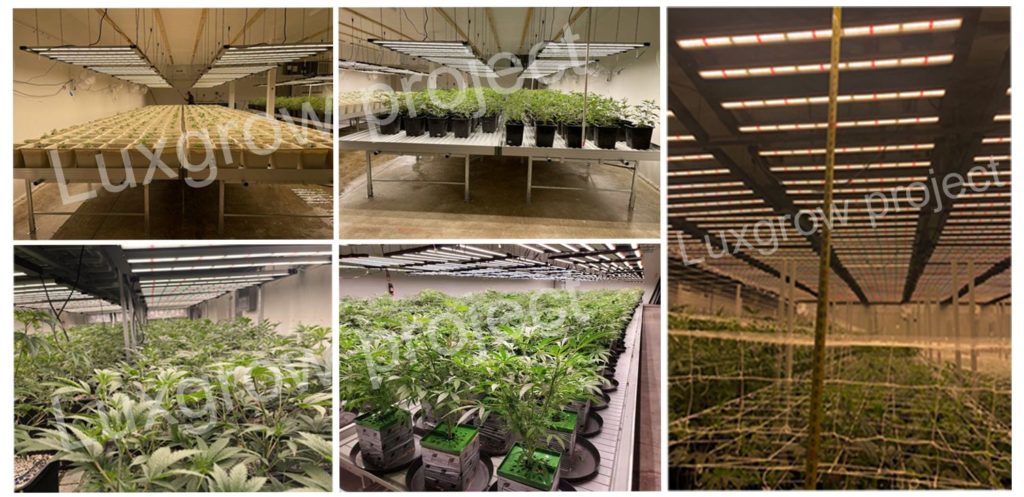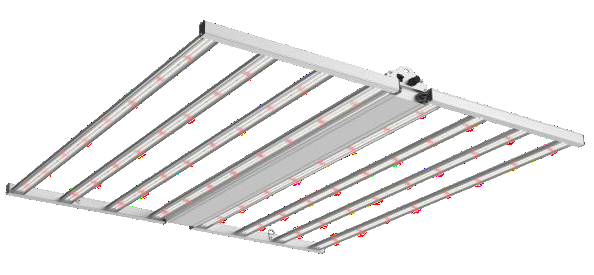Full Spectrum LED Grow Lights offer adjustable wavelength and spectrum, higher yields, for indoor and greenhouse cultivation. Most models are dimmable and distribute broad, full-spectrum light anywhere from 50% to 100% while maintaining efficiency. Full Spectrum LED Grow Lights also offers a large 5’ x 5’ bloom coverage area and 8’ x 8’ foot vegetative coverage area. High efficiency of 2.5umol/j and 0–120-W power consumption contributes to efficient growing operations. Light output from our full spectrum grow lights promotes photosynthesis at all stages of growth and a comfortable environment to assess and maintain crops.
MB2
Brand: Ledsion
Full Spectrum LED Grow; Light features a rack lighting solution designed for single or multi-tier growers; available in 660/720W;
Prices start at $500.
Light Distribution Curve:
1. Wavelengths more than 1000nm can not participate in photosynthesis, but can only be converted into heat energy.
2. The wavelength of 1000nm-720nm, which can promote the growth of stems and have a certain effect on flowering and germination.
3. The wavelength of 720nm-610nm is the strongest absorption band of chlorophyll, which has strong photosynthesis, in many cases also exhibits strong light periodic effects.
4. The wavelength of 610nm-510nm, which is the inefficient region of photosynthesis and weak shaping effect.
5. The wavelength of 510nm-400nm is the strong absorption band of chlorophyll and yellow pigment, the second peak area of photosynthesis, and strong shaping effect.
6. UV-A with a wavelength of 400nm-320nm can make plants dwarf and leaves thicker. Most pests have phototaxis to radiation in this wavelength.
7. The dark blue at 450nm and the dark red at 660nm are the optimal spectrum for plant growth and lighting. These two bands can be called the “light fertilizer” of plants.
Blue LED around 450nm promotes germination
Red LED around 660nm promotes photosynthesis, germination and flowering
What is a good PAR reading for growing plants?
To determine how good your PAR output is, you’ll need to consider what stage your plants are in and what your goals are as a grower. PAR readings between 200-400 PPFD are great for seedlings, clones and mother plants.
These younger plants and mother plants have lower light intensity requirements than a flowering plant would, and extending out of this range would be overkill. Here, you will see growth rates between 30-55%.
As your plants progress through veg and you want to encourage robust, vegetative growth, PAR readings should be between 400-600 PPFD. Here, growth rates can spike up to 85%.
One common misconception is that to increase growth further, you can bump up PPFD. However, there are diminishing returns based on a plants specific stage of growth, and in this stage 85% growth is right where you want to be.
Once your plants are flowering, readings between 600-900 PPF are ideal. This will encourage heavy buds, and increase the quality and quantity of your harvest.
Once you shoot past 1,000 PPFD, your plants will reach a point where they can’t use anymore light.
They become carb limited, and the only way to increase growth further is by supplementing with CO2.
CO2 can be very effective at supercharging plant growth, but only if light is at a certain level (above 1,000 PPFD)


